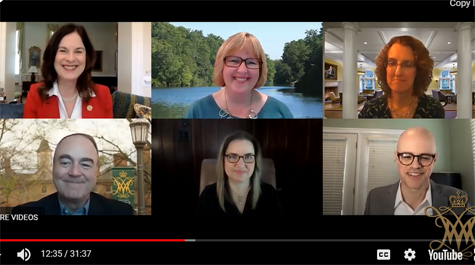W&M looks to carry lessons gained this year into the future
William & Mary’s response to the challenges of the pandemic helped it establish skills, insight and efficiencies that will help carry it into the future.
“The adversity of this past year is going to push us past the status quo. It has,” W&M President Katherine A. Rowe said during a virtual Community Conversation on Tuesday focusing on the next phase of the university’s strategic planning efforts: Vision into Action. The discussion was the last in a series of Community Conversations that Rowe held this year on a variety of topics.
“Our goal as we change is to advance what we value most,” Rowe continued. “We have to keep that in mind at all times, to connect the passion and the purpose of this university together as we keep taking steps forward to put our vision into action."
{{youtube:large:left|VJEmbKYItBM}}
Rowe’s guests for the Community Conversation were Provost Peggy Agouris, Vice President for Student Affairs Ginger Ambler, Vice President for Strategic Initiatives & Public Affairs Henry Broaddus, Vice Provost for International Affairs and Director of the Reves Center for International Studies Steve Hanson and Chief Operating Officer Amy Sebring.
They discussed the strategic planning white papers that were first authored in January 2020 and recently revised to reflect lessons gained during the pandemic.
The papers surveyed the landscape and future for three core mission areas: teaching and learning, research and innovation and flourishing and community engagement.
Rowe said the main themes from the white papers and community feedback will guide W&M’s cabinet over the summer in shaping a longer-term vision for the university.
“We need to continue to build new strengths in every sense, whether it’s financial, whether it’s about energy efficiency, about wellness, about the way we use space for learning and other kinds of work, and we need to capitalize on what we’ve learned about remote work and learning,” Rowe said.
Technology gains
The William & Mary community tapped into many online resources during the pandemic to meet a variety of needs, from remote work and learning to engagement with potential students and alumni.
“If we think about our engagement with alumni, we did over 800 programs serving 58,000 alumni this year, a 67% increase year over year,” Rowe said. “And the alumni who connected, they are more generationally diverse, more geographically diverse, more racially diverse, more diverse in just about every way. And that is what we want for our amazing community. We want that sense of connection.”
Remote work and learning came with mixed reviews, but it was essential to many students and employees who were unable to return to campus.
“We were teaching international students of William & Mary around the world through Zoom and online technology this year, fairly successfully,” Hanson said.
“We’re still going to do the in-person things,” Hanson added. “Those are really important. But this is part of our portfolio now.”
Student recruitment is another area that benefited from the technology pivot during the pandemic, resulting in a 20% increase in applications this year.
Broaddus said the Undergraduate Admission moved swiftly to create a variety of campus tours to meet prospective students’ needs, including a rich media virtual tour, an enhanced self-guided tour and a student-led tour in remote modes.
“I think that is an example of the incredible growth capacity on different ways to reach prospective students, and that also should enable us to rethink our commitment to equity, diversity and inclusion in really exciting ways,” Broaddus said.
A collaborative effort
The pandemic also presented a critical need for more collaboration across many different departments.
“We saw how successful our Public Health Advisory Team and our COVID Response Team have been in how our university handled the pandemic,” Agouris said. “Both teams comprised members from various domains of our university and brought together complementary expertise that helped us respond to the crisis successfully.”
Sebring said many of the institutional silos that were once thought to be potential impediments have come down.
“I think one of the silver linings of the pandemic is that it has shown us how individually we can work differently but also how collectively we can work differently,” Sebring said.
The pandemic also emphasized the importance of human connection, Ambler said.
“We found that human connection can still be accomplished in virtual modes, but the desire for an on-campus experience and in-person classes emphasized the strong desire for that deep human connection,” Ambler said.
Ambler said another takeaway from the white papers was a desire for open communication and transparency about decision making that will remain critical in keeping the community engaged in planning and also for affirming a sense of belonging and respect on campus.
Rowe closed the Community Conversation by congratulating W&M’s 2021 graduates and the university community for all they accomplished in the last year.
“We held fast to our goals, and we navigated this incredible and difficult academic year together,” Rowe said. “It’s been an extraordinary experience of a community pulling together under real strain.”
 Skip to main content
Skip to main content

